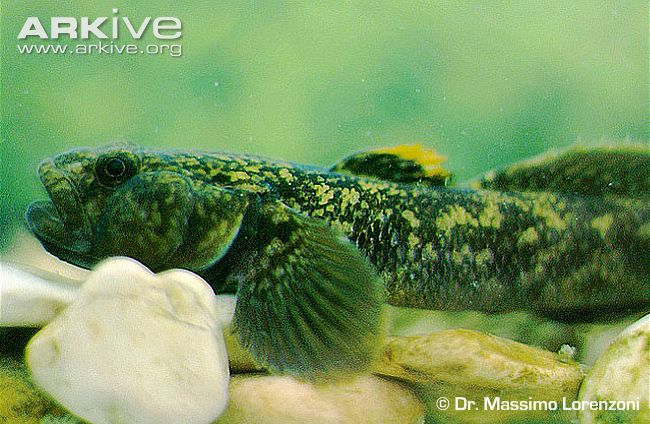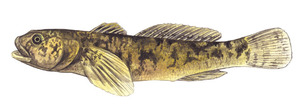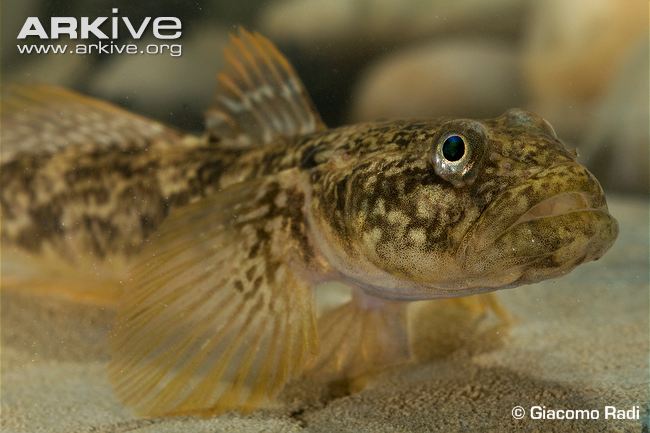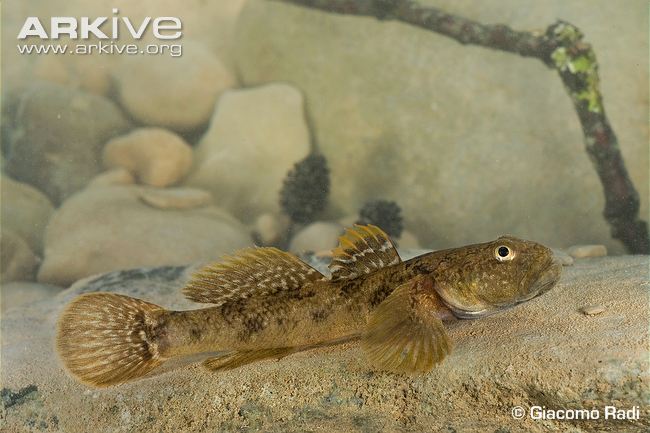
Padogobius nigricans
FAMILY
Gobiidae
TAXONOMY
Gobius fluviatilis var. nigricans Canestrini, 1867, Arno River, Italy.
OTHER COMMON NAMES
Italian: Ghiozzo di ruscello.
PHYSICAL CHARACTERISTICS
Males reach slightly beyond 4.9 in (12.5 cm) total length.
Tubular species with a blunt head and terminal mouth. Two
dorsal fins, second with 12–14 fin rays. Rounded caudal fin.
Pelvic fins form a sucking disc, which does not extend as far as
the anus. There are 44–49 ctenoid scales along the midline of
the flanks. Brownish or light brown dorsally, and whitish ventrally.
Five characteristic brown bands over the back, the first
at the base of the pectoral fin and the last at the caudal peduncle.
Dorsal fins with alternating light and dark gray bands; the
first dorsal fin has a yellowish orange border.
DISTRIBUTION
Formerly widespread through fresh waters of central Italy.
Currently found in the Serchio, Arno, Ombrone, and Tiber
River basins. Populations have become restricted because of
environmental degradation and pollution.
HABITAT
Small to medium-sized streams with moderate current. Usually
found in clear waters, over a stony substrate.
BEHAVIOR
Usually stationary, positioned under stones, occasionally moves
quickly from one stone to another.
FEEDING ECOLOGY AND DIET
Predaceous; feeds on oligochaetes, crustaceans, and insect larvae.
REPRODUCTIVE BIOLOGY
Probably reaches sexual maturity during the first year, at 1.6–2
in (4–5 cm). Males become very dark during the reproductive
period, which usually occurs between May and June. The male
is territorial and guards a nesting cavity under a stone, attracting
females with a courtship display and making noises as he
does. The male carries small stones out from the nest in his
mouth and deposits them near the female, and then quickly returns
to the nest. He repeats this
BEHAVIOR
until the female enters
the nest, and then swims several times upside down over
the roof of the nest. The female attaches herself to the roof of
the nest using the pelvic disk and spawns 100–200 eggs, which
are stuck to the roof. Several females can spawn in the same
nest, which may hold over 1,500 eggs at various stages of development.
The male cares for the eggs until they hatch, after
about 17 days.
CONSERVATION STATUS
Listed as Vulnerable by the IUCN, with a suspected population
reduction of at least 20% over the last 10 years, or three generations.
Populations are threatened by environmental degradation
and, in some areas, by the introduction of Padogobius martensii,
which probably competes for similar ecological niches.
SIGNIFICANCE TO HUMANS
There is no commercial or sports fishery for this species.
However, the flesh tastes good and fishes are collected illegally
and eaten fried.
Other popular Animals
Photo Gallery of - Arno goby





 Animalia Life
Animalia Life